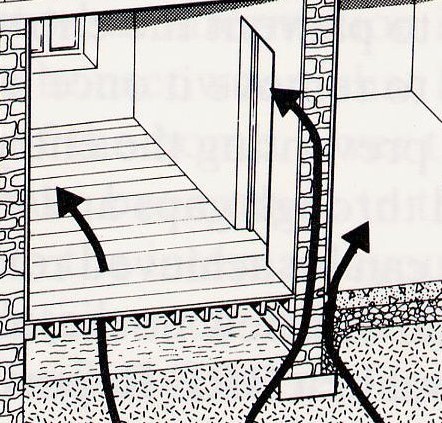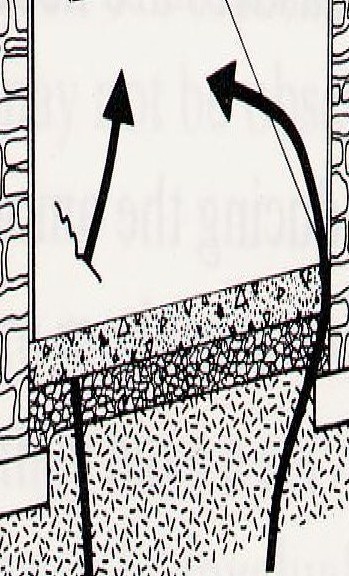


HHSRS VERSION 2
SEPTEMBER 2004
RADIATION (RADON)
Elderly persons, lifetime exposure
Damp
Vulnerable age
Related hazards
Front elevation
HHSRS VERSION 2
Multiple locations
Yes
No
Secondary hazards
Yes
No
Radon/rating table
Radon
Likelihood
Bqm-3
1 in
Rating
score
B) Rear dining room floor
C) Front living room & spine wall
Rating
band
B
C
D
D
E
E
F
800
277
3,285
400
518
1,757
200
1,000
910
150
1,322
688
100
1,961
464
50
3,902
233
25
7,853
116
DESCRIPTION OF HAZARDS
Dwelling: 1850's 4 bedroomed detached farmhouse
A)
B)
C)
LIST OF RELEVANT MATTERS
LIKELIHOOD & OUTCOMES
A
B
C
# Secondary hazards
A
B
C
a
Timber ground floor
-
-
3
-
None
-
-
-
b
Disrepair to solid floor
3
1
-
c
Lack of DPM
3
2
2
d
Sealing around services
3
-
-
e
Ventilation rates
-
-
-
f
Open fires
-
-
-
Key
3
Seriously defective
g
Remedial measures
-
-
-
2
Defective
h
Extractor fans
-
-
-
1
Not satisfactory
i
Private water supply
-
-
-
-
Satisfactory/NA
Background: This large, two storey detached farmhouse is in a radon affected area. It is built
with random rubble stone, rendered walls and has a variety of floor constructions.
Kitchen: At the rear of the house, there is a flag stone floor to the kitchen, the flags being laid
directly onto the soil. Most of the kitchen walls show signs of rising damp.
Dining room: There is a solid concrete floor to the rear dining room and like the kitchen floor this
also shows evidence of rising damp, as do two of the walls.
Front rooms: The two ground floor front rooms have butt jointed, suspended timber floors. There
are two air-vents to the front wall, but no others, and rising damp in the spine wall.
Average likelihood, outcomes and HHSRS score for radon for persons aged 60 to 64
years in all dwellings, following lifetime exposure
HHSRS VERSION 2
SEPTEMBER 2004
HEALTH AND SAFETY RATING SYSTEM SCORES
Pre 1920 House
LIKELIHOOD
1 in
100
Low
High
Average: 10,000
Example
100
< 4200 2400 1300 750 420 240 130
75
42
24
13
7.5
4
2.5
1.5 >
Justification
OUTCOMES
Class I
Class II
Class III
Class IV
Justification
RATING
There is sufficient evidence to suggest a radon problem and subsequent measurements
show a level of over 2,000 Bqm-3, way above both the average for radon affected areas
and the recommended action level of 200 Bqm-3. Information from NRPB and other
sources (see table overleaf) indicates that this would give an annual risk of cancer of
around 1 in 100.
%
90.0
10.0
0.0
0.0
Average: 90.0
90.0
< 0.05 0.15 0.3
0.7
1.5
3
7
15
26
38 >
Av: 10.0
10.0
< 0.05 0.15 0.3
0.7
1.5
3
7
15
26
38 >
Av: 0.0
0.0
< 0.05 0.15 0.3
0.7
1.5
3
7
15
26
38 >
Av: 0.0
0.0
< 0.05 0.15 0.3
0.7
1.5
3
7
15
26
38 >
The radon level does not alter the spread of outcomes.
Score
284
Example
A B C D
Average: 91
E F G H
I
J
Score
9100
RATING SCORES AFTER IMPROVEMENT
Likelihood to
1 in
3,200
Outcomes to
90.0 10.0
0.0
0.0
%
IMPROVE
Justification
NEW RATING
Av: Nos
The installation of a radon sump under the centre of the house, close to the spine wall,
is found to reduce the radon level to just over 70 Bqm-3 and thereby the likelihood to
around 1 in 3,200 and the rating score to 284 - reducing the Band from A to E. As the
dwelling is in a high radon gas risk area, some risk remains.
Av: 91
G H
I
J
Improved
A B C D E F